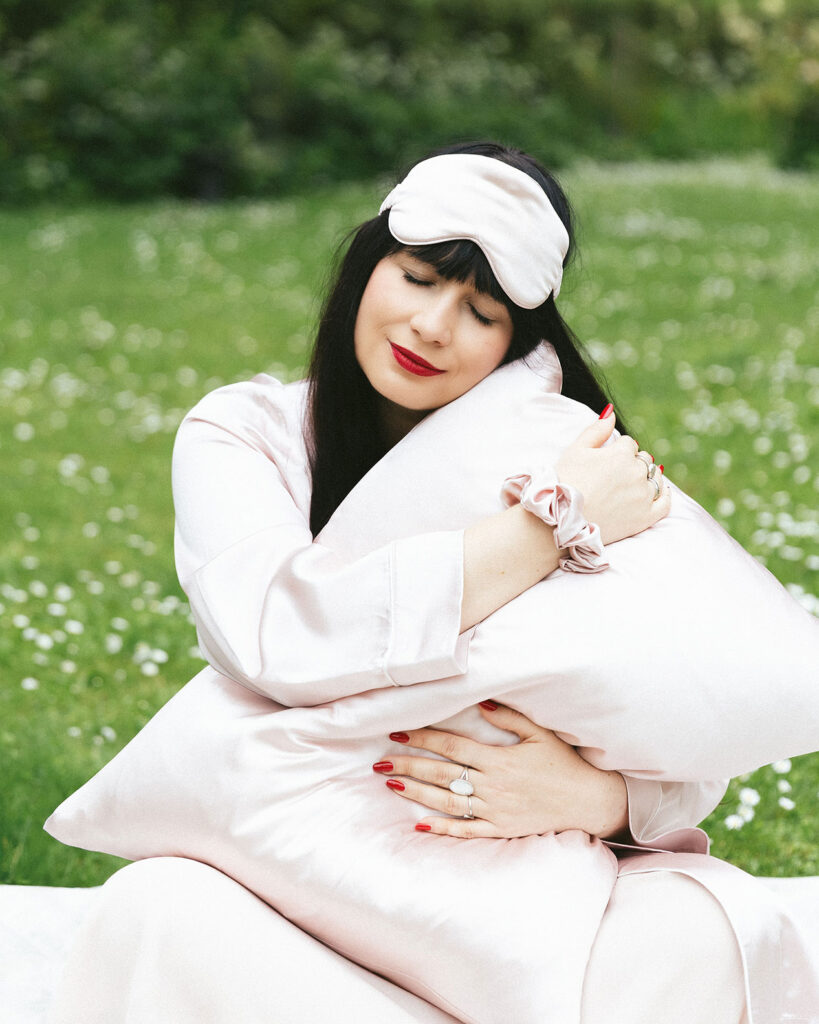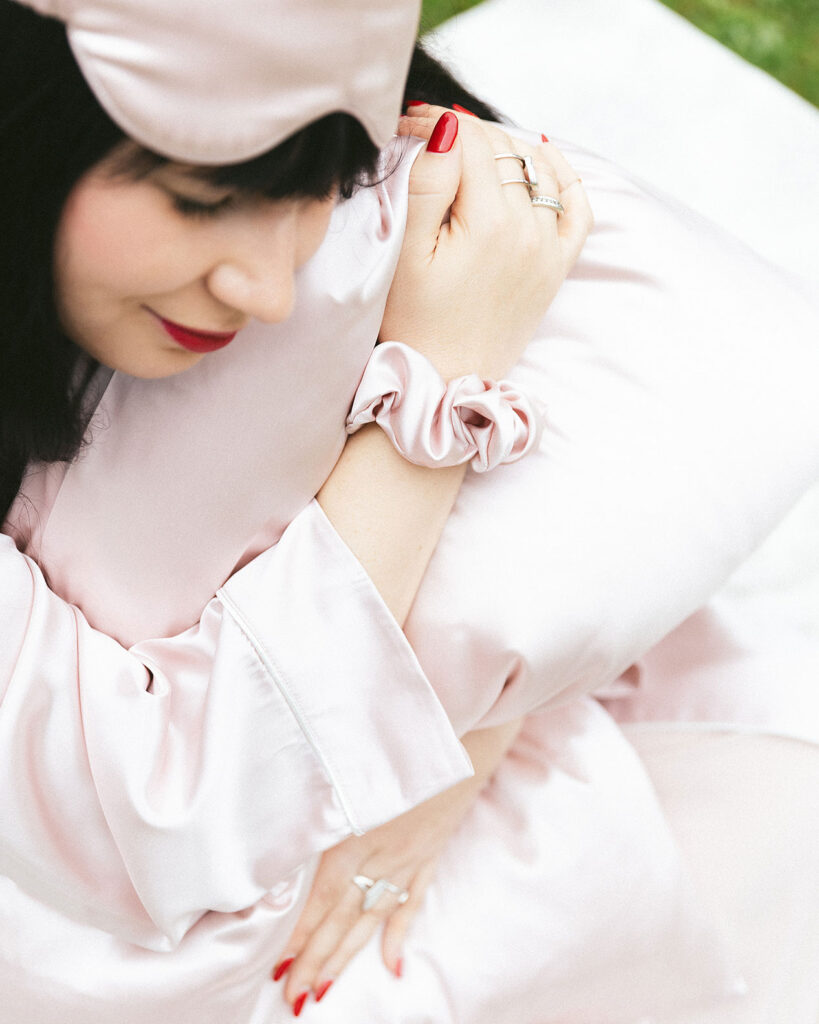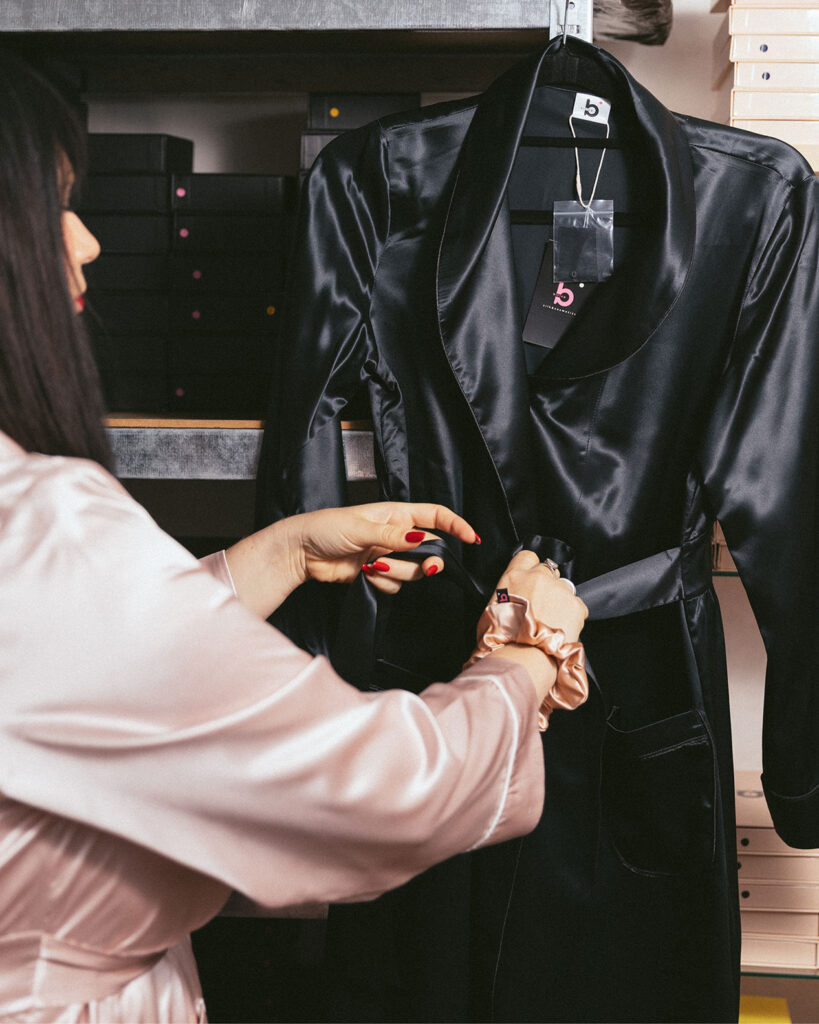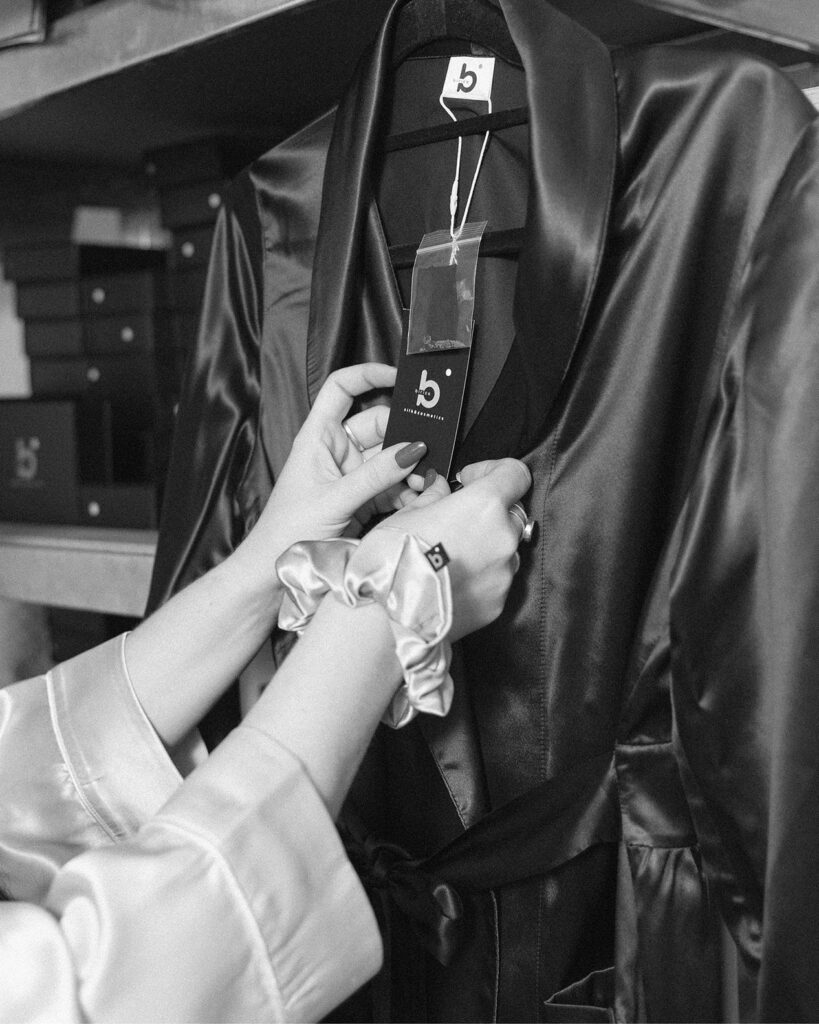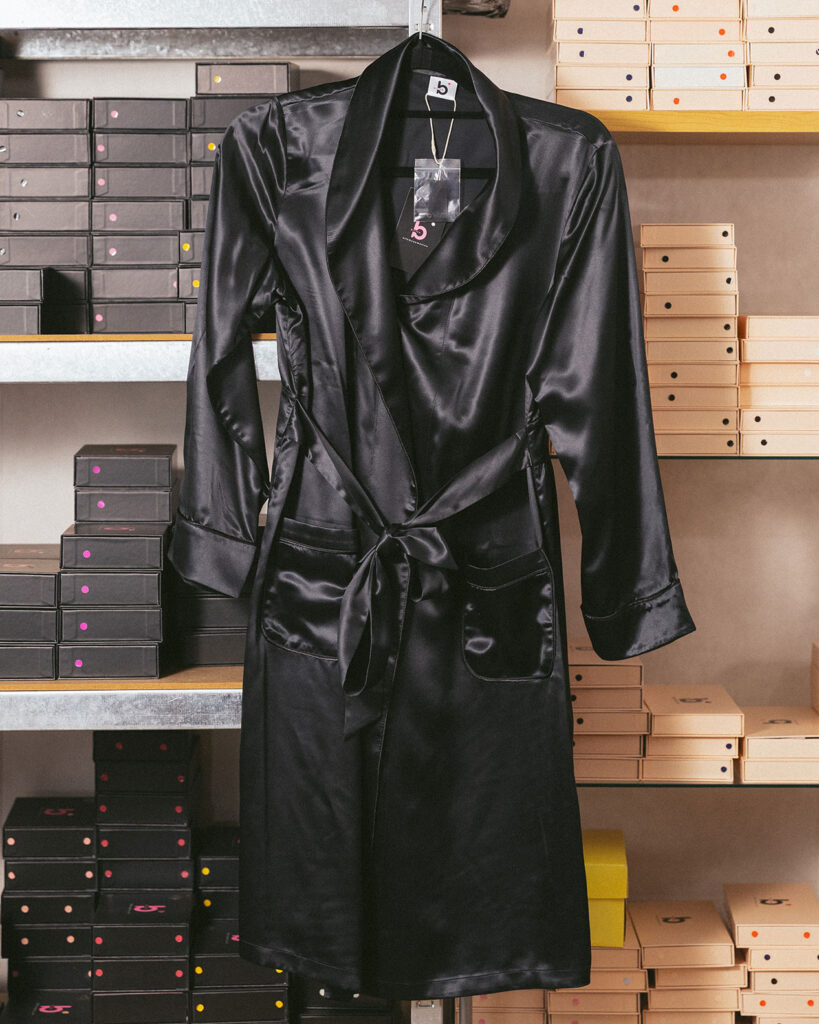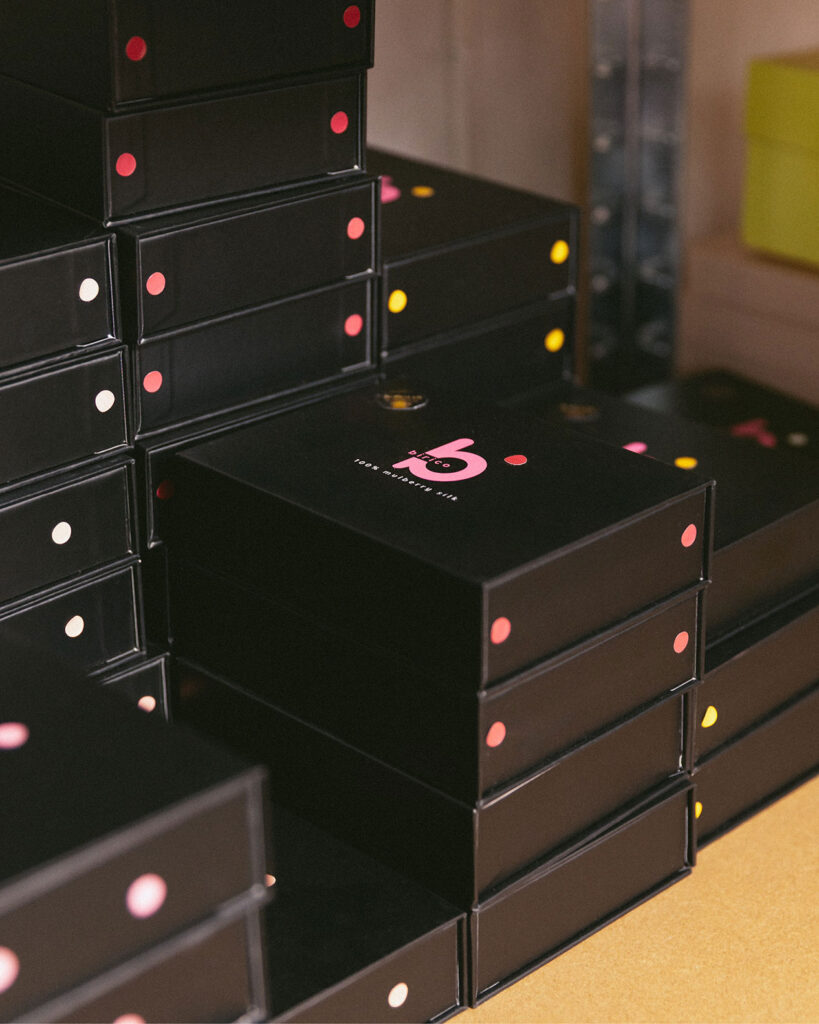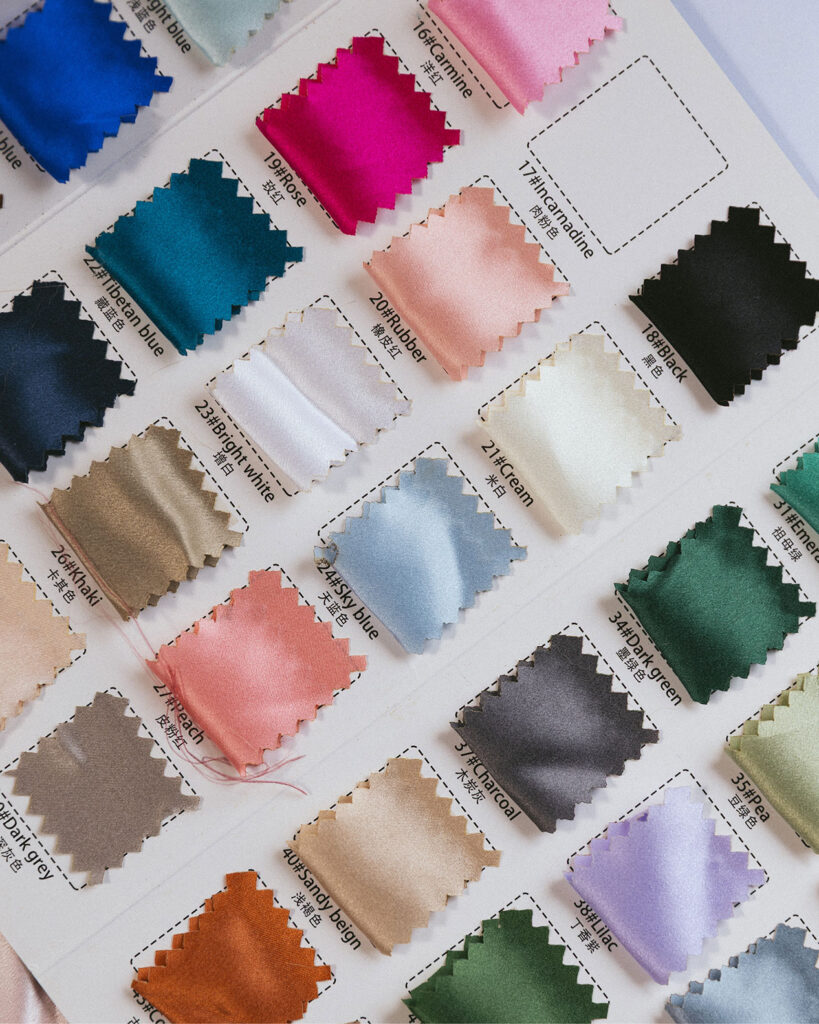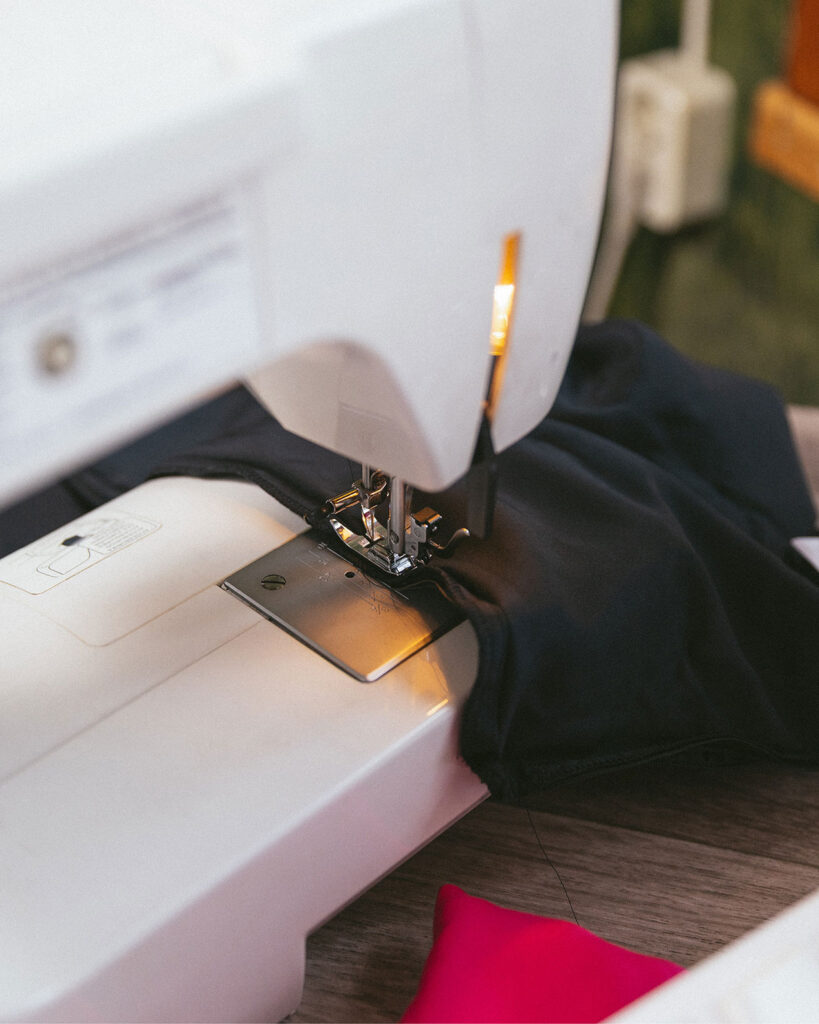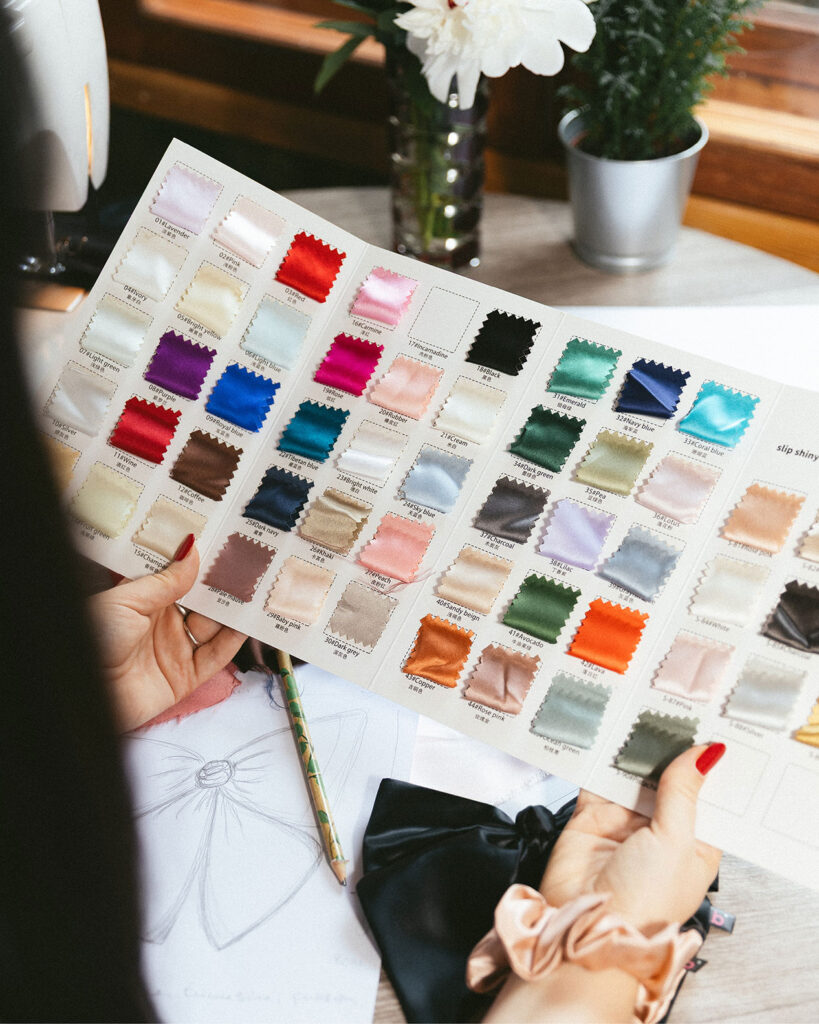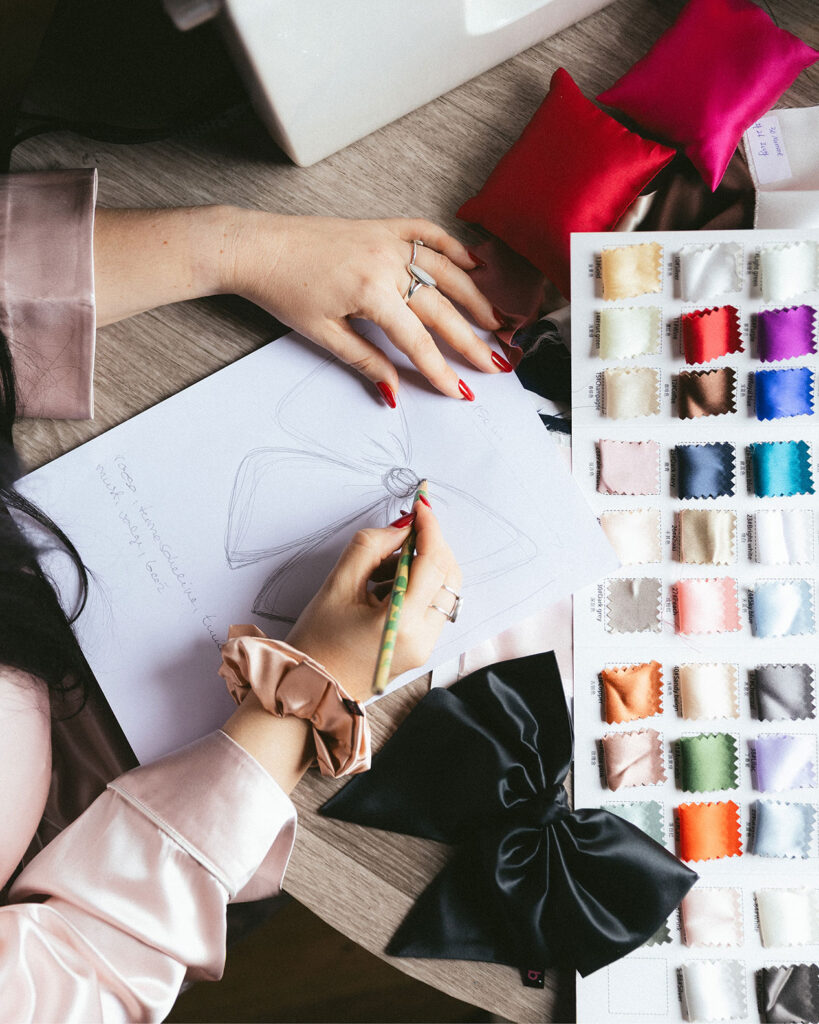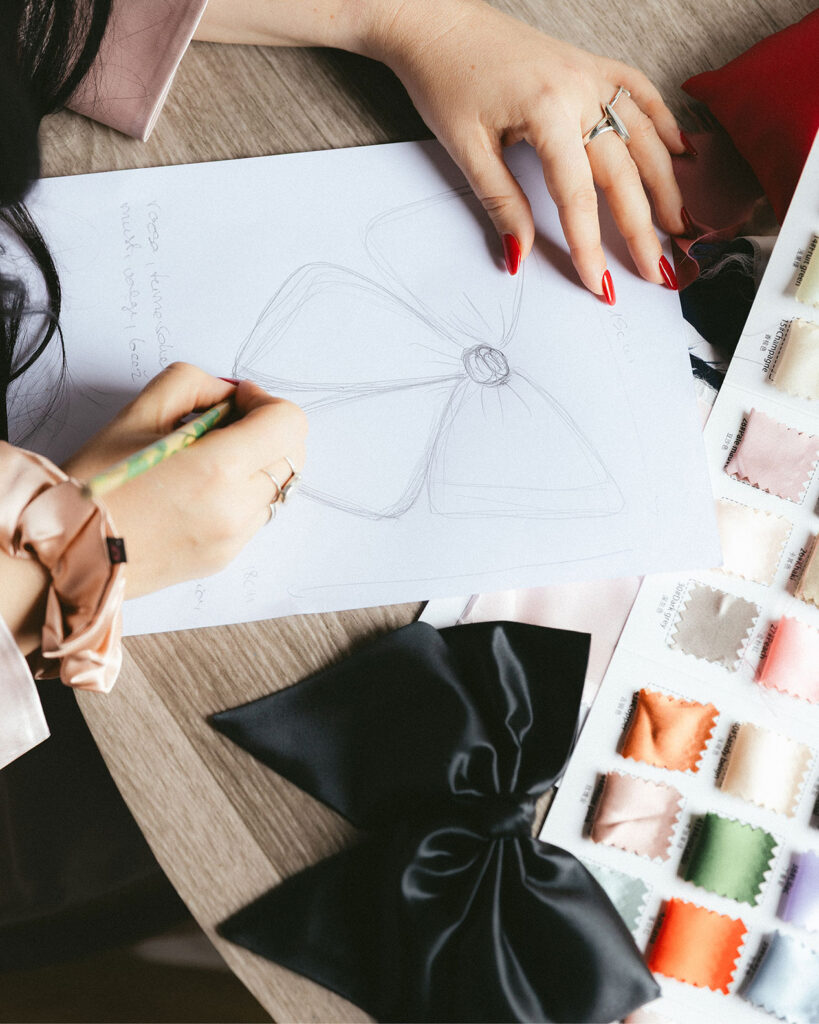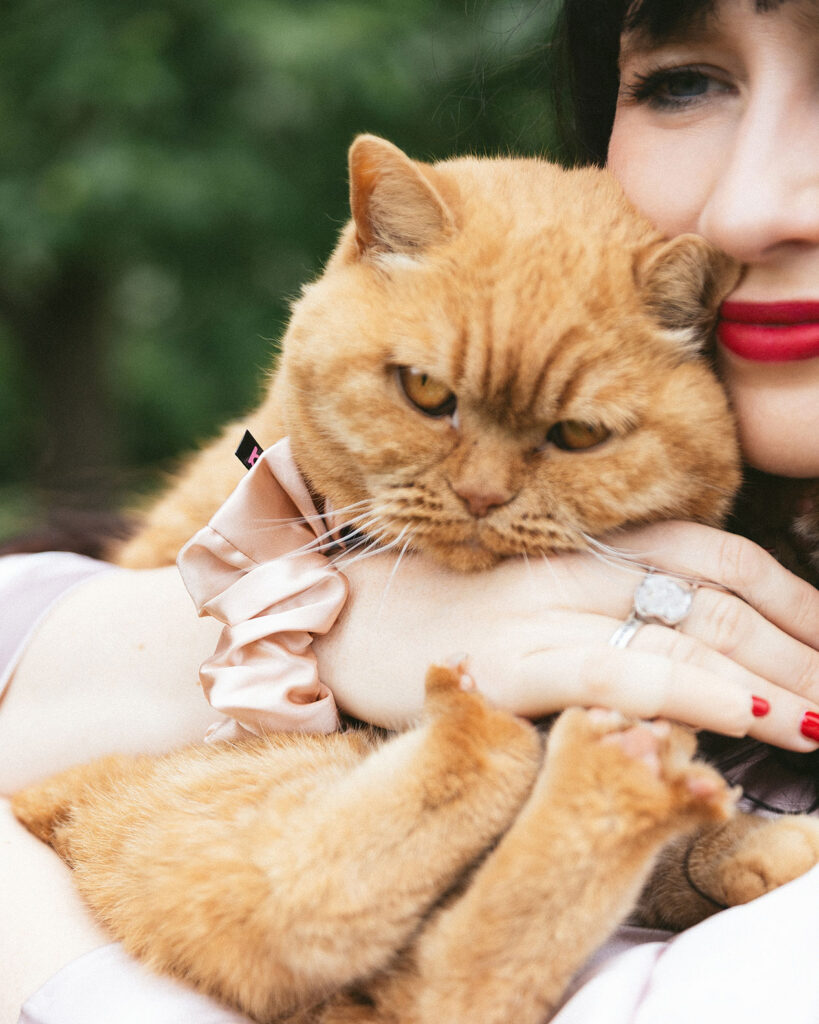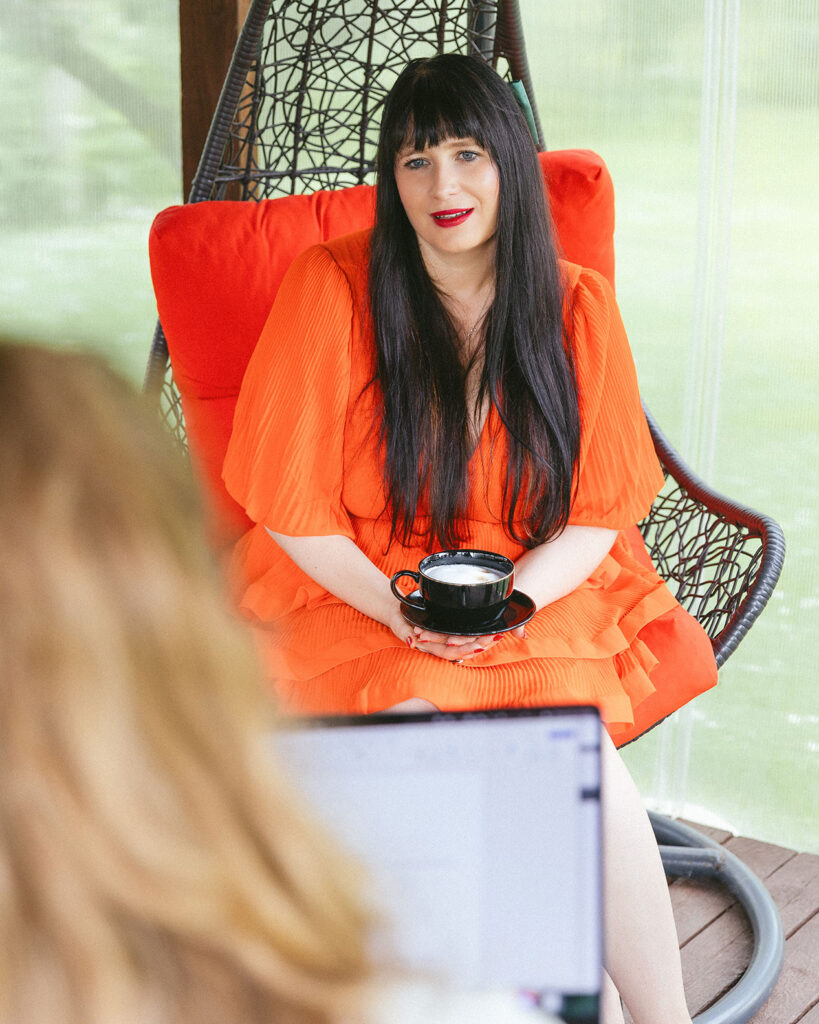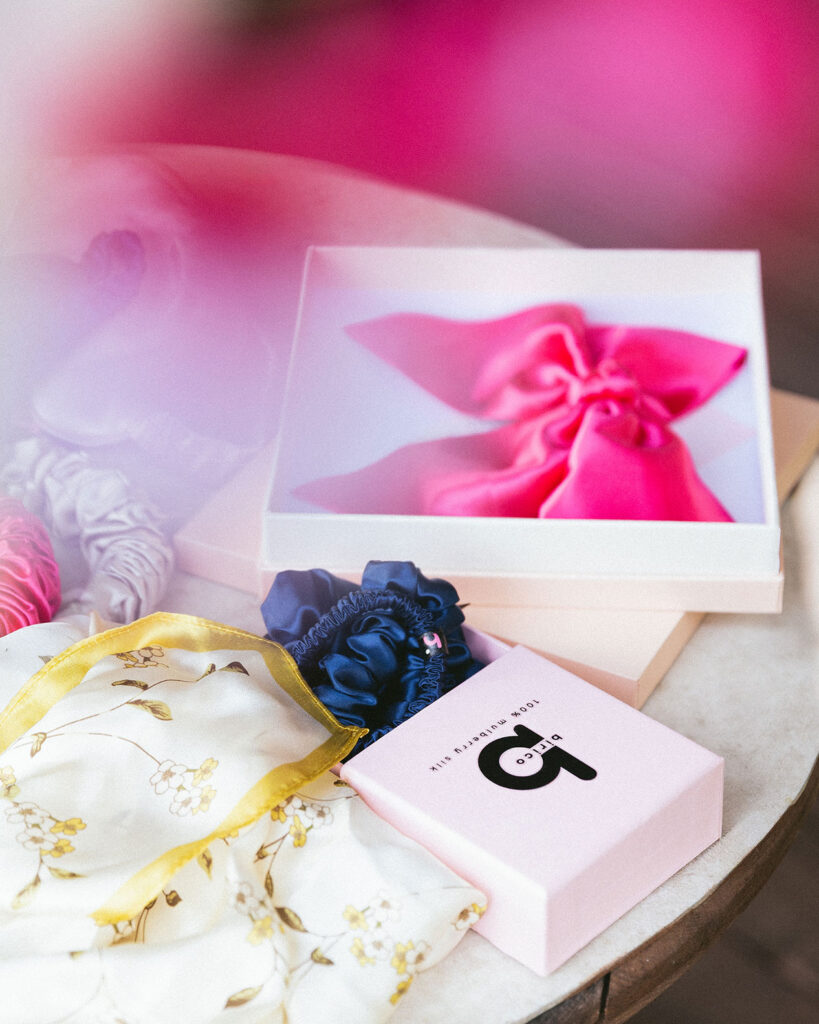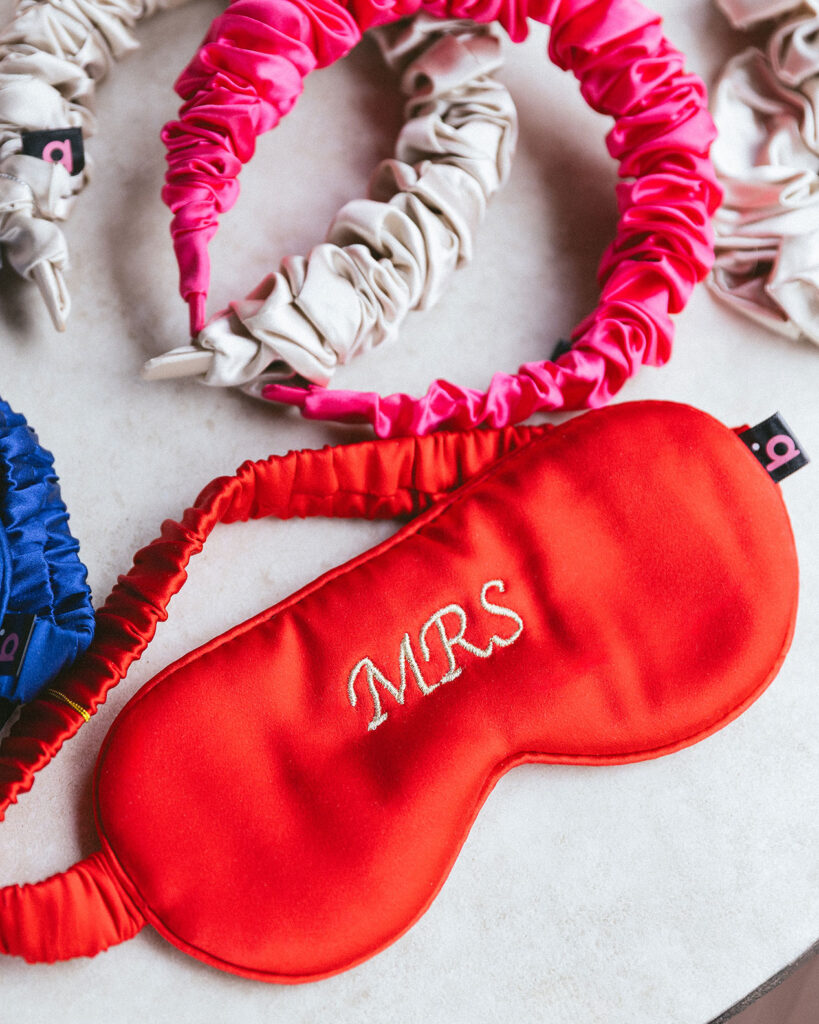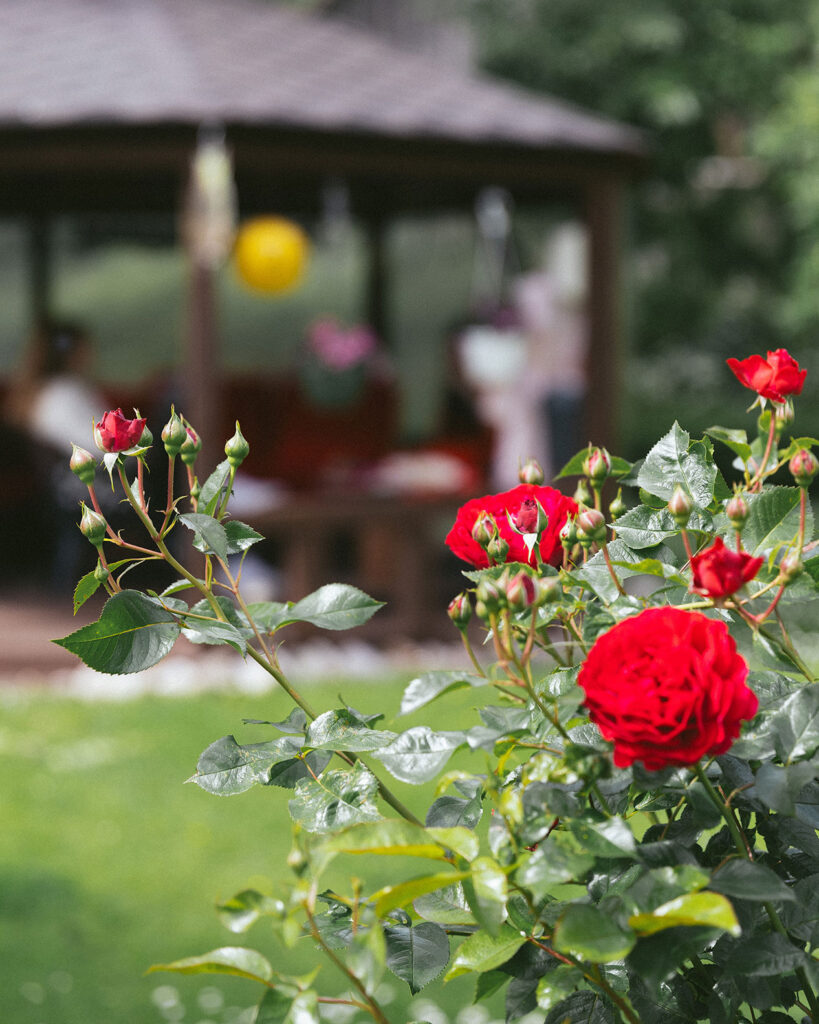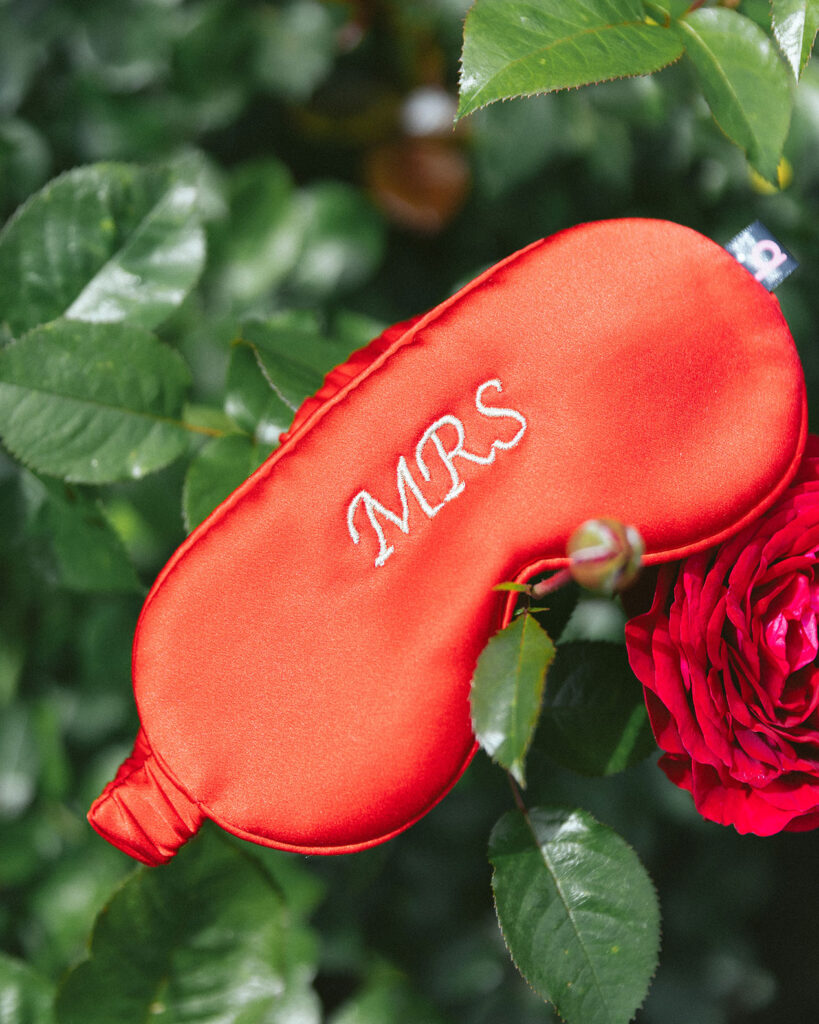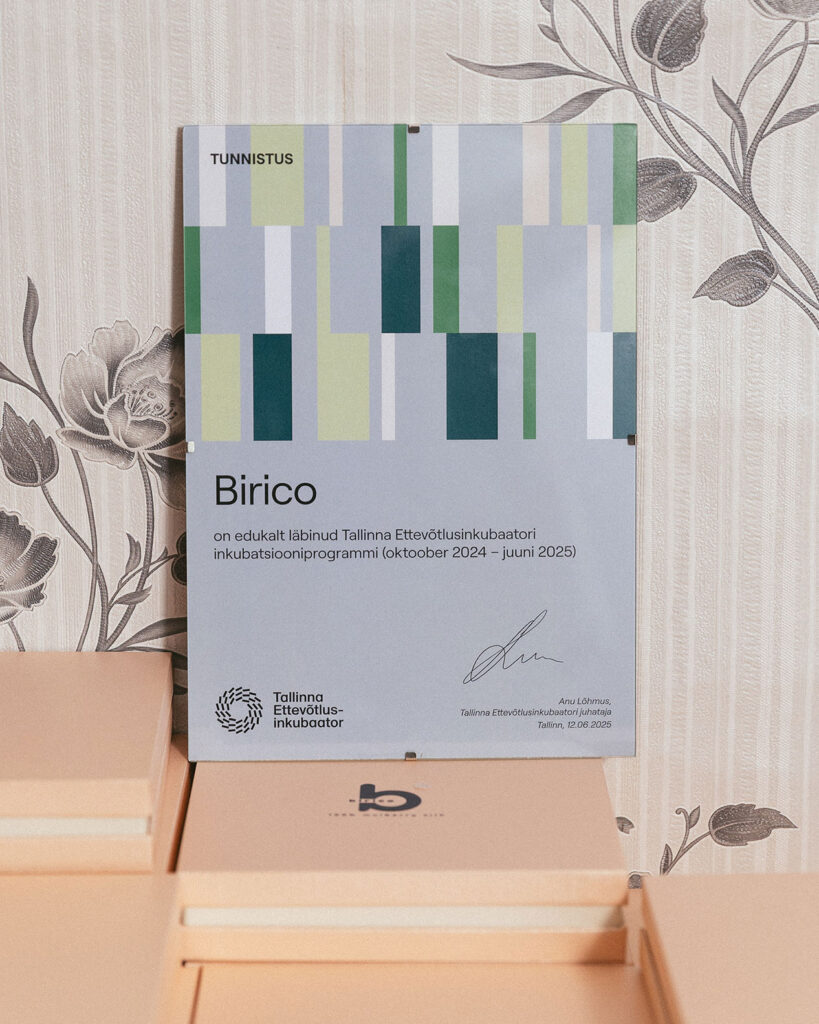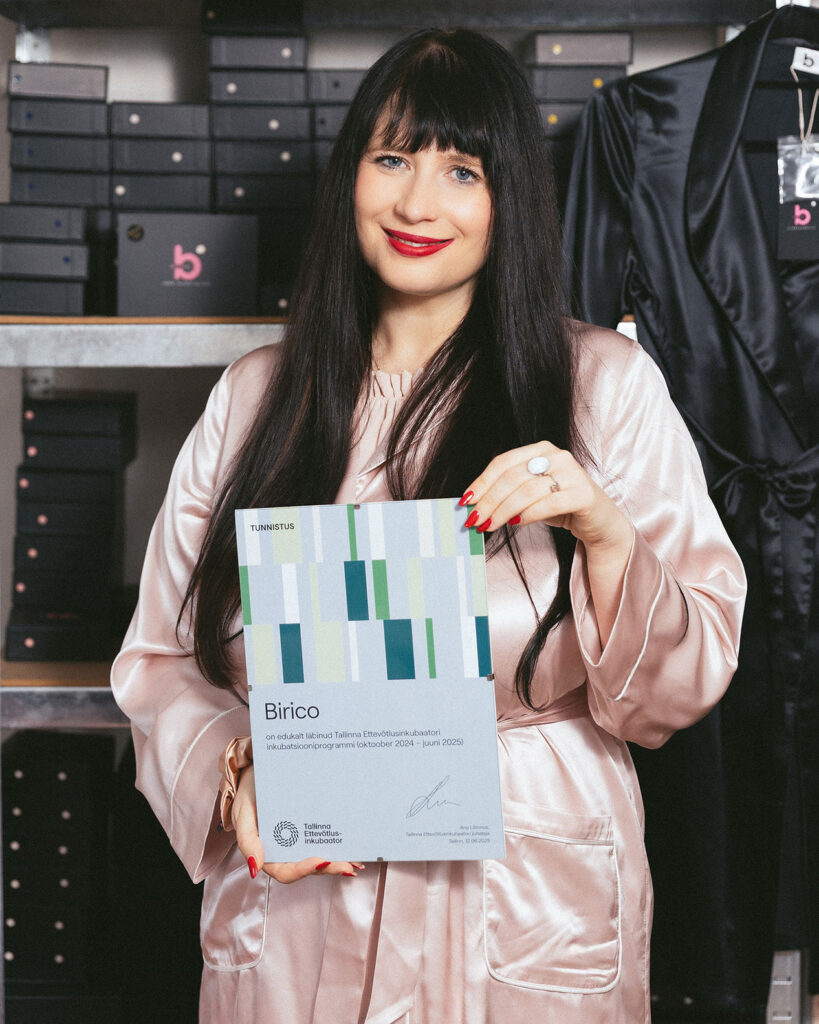Birico creates functional products made of silk. The word “functional” might sound a little vague, but what I mean are items that enhance our daily lives – making them more comfortable, more beautiful, and more stylish. I’m not painting the Mona Lisa, but I am designing a dressing gown that makes you feel feminine and fabulous. And while you’re wearing it, it also takes care of your skin.

Birico: luxurious yet practical silk
01.08.2025
This time, as part of the Tallinn Design House Artist Series project, we visited the founder of the Birico brand, Birgit Usin, at her charming home near the forests of Jüri. It’s here that seemingly simple, yet deeply considered silk products are brought to life.
What does Birico do?
What’s your background, and how did you end up working with silk products?
I’m a bit of a jack-of-all-trades. I studied international relations but have worked in all sorts of jobs. I’ve been an airport security officer, and I spent six years working as an accountant at Coca-Cola. Since 2010, I’ve been involved in event management to varying degrees.
When COVID hit and events came to a halt, I found myself stepping into entrepreneurship. I had always wanted to run my own business, but something was always holding me back. I was afraid of losing the security of a steady paycheck. But when I was made redundant, I started by importing natural cosmetics from Ukraine.
A year later, when the war in Ukraine began, the business became much more difficult. Sometimes the goods got stuck at the border; other times, they were stolen from delivery vans. My stock levels dropped, but I still had customers to serve. At the same time, I was under immense stress and anxiety, which started affecting my sleep.
Those two things – needing new products and experiencing sleep issues – led me to silk. I kept coming across information suggesting that silk scrunchies protect your hair and silk pillowcases help improve sleep. Since I was already selling shampoos, it felt like a natural fit. I found a lovely family business in China that agreed to produce a small batch of products based on my design and specifications. Once the items arrived in Estonia, the interest was overwhelming.
As communication with Ukraine became increasingly difficult, I decided two years ago to create my own brand. At first, I didn’t really know what I was doing. But a French friend of mine, who is a coach, told me: start with what you already have. And what I had was silk.
It took nearly two years to develop the first products, branding, and the name. Finding the right name alone took six months. And here I am today.
So where does the name Birico come from?
I once had a cat who absolutely loved silk pillowcases – but sadly, she’s no longer with us. Inspired by her, I initially wanted to play around with a name like Silk Cat. But as it turned out, a concrete company had already taken it.
I also wanted to bring in a hint of Nordic feeling – something along the lines of Cold Frost – but obviously, domain names like that have long been snapped up for big money.
One of the most important people in my life has been my grandfather. One evening, while lying in bed with my partner, I said that I wanted to somehow connect this brand with him. My grandfather used to call me Biri. On its own, that name didn’t sound quite right to me – but then, just a few minutes later, my partner said: What about Birico?
It instantly felt perfect. Biri – those are my roots, my story, my heritage. Co – that represents all the people who stand behind me and support me. Together, it becomes Birico.
I also definitely wanted the name to have a bit of an international flair. I started researching how brands used to be named in the 1940s in the US – they would take bits and pieces from different sources and put them together. The 1940s were also a time of awakening for women – the pin-up era. And I thought to myself: this is a sign. This is the right name.
Why is silk such a great material, and what type of silk do you use?
There are over 20 different types of silk in the world. When it comes to natural silk, the name usually depends on what the silkworms are fed – or what the silk is blended with. Indian silk, for example, comes in several varieties, but often contains only a small percentage of real silk. There are also exotic silks made from things like spiderwebs, but those are, of course, extremely expensive.
I use Mulberry silk. It gets its name from the fact that the silkworms feed on the leaves of the Mulberry tree. It’s one of the most luxurious and pleasant types of silk in the world.
In fact, silk as a material does about 70% of the work for me. Mulberry silk is wonderful because it’s incredibly smooth. At Birico, 99% of our products are made from high-shine silk. When you rest your head on a silk pillowcase, friction is reduced by 60% compared to a cotton one. Cotton pillowcases affect your facial skin on a micro level every single night, gradually thinning it. And the thinner the skin, the faster you develop wrinkles, dark circles, and other skin concerns.
We often focus on creams and toners, but forget that our face is in direct contact with a pillowcase for nearly eight hours straight. And we don’t wash our pillowcases that often – ideally, a regular one should be washed at least once a week. With silk, it’s much easier: it doesn’t absorb bacteria, dust, or fungi, making it ideal for allergy sufferers, including those with dust allergies. For acne-prone skin, pillowcases should technically be changed daily to avoid the cycle of bacteria transferring back onto the face. With silk, that’s not an issue.
Silk also doesn’t absorb moisture. If you apply expensive creams to your face or treatments to your hair overnight, a regular pillowcase will soak it all up. Silk, on the other hand, leaves the goodness on your skin and hair. I have very fine but dense hair, and I used to wake up with tangles every morning – not to mention static during the winter. When I switched to a silk pillowcase, that problem disappeared completely.
Silk is also fantastic for hair ties. A regular elastic band puts pressure on a specific point in the hair, causing breakage, creasing, and weakening. A silk scrunchie holds your hair without damaging it, without absorbing moisture, and without leaving any marks.
But my favourite feature of Mulberry silk is its ability to regulate temperature. When the room is warm, silk feels cool. When it’s cold, it retains your body heat. One of the reasons I had trouble sleeping was because my pillow would heat up quickly when I felt anxious, and I’d often wake up. Since switching to a silk pillowcase, I barely ever turn it over – it stays just as comfortable all night long. When I travel, I always take my pillowcase with me. On the one hand, it helps physically, and on the other, it creates a sense of home and helps me fall asleep faster.
We also offer various types of silk sleep masks, which help, for example, with dry eyes. I’ve had several eye surgeries myself, and thanks to silk, I experience less dryness and the skin around my eyes is in better condition. Research shows that sleeping with a mask helps you fall asleep faster, leads to deeper sleep, and reduces anxiety. Silk adds an element of skincare and luxury to that. In fact, studies show that people sleep 68% better with a sleep mask – and if it’s made of silk, that improves by a further 30%.
And finally, silk simply feels good. We share our time and belongings with our families constantly, but when you have something that’s just for you and gives you that special feeling every time – you realise how important that is. Mulberry silk is now far more accessible and no longer prohibitively expensive. It gives you a boost of confidence and femininity. Just like beautiful lingerie – no one else sees it, but you know it’s there.
Have you considered using any other materials?
Actually, no. There are so many amazing designers both in Estonia and around the world, and I believe that focusing solely on silk – and exploring as many different uses for it as possible – is exactly what sets me apart.
The material itself already does so much of the work. It has a long, rich history and has played a major role in economic development – just think of the Silk Road. That’s why I haven’t even seriously considered other materials.
Where do you find inspiration for new products?
Very often, inspiration comes from personal needs. At the same time, I’ve been lucky to be surrounded by many inspiring women – so many of my ideas stem from the needs of other women as well.
Take the dressing gown, for instance. I once heard my friend, a mother of three, say that she’s constantly losing the belt on hers. She loves silk but doesn’t want to be half-naked around her kids. Or that robes are often too short and don’t offer enough coverage, making you feel exposed. It’s moments like these that start to build a visual in my head.
I’m a very visual person. Although I graduated from a science-focused school and have worked in analytical fields, creativity and visual thinking are very much a part of who I am. When I get a vision, I can’t rest until I’ve either written it down or sketched it out – and that’s usually how a product is born.
I also feel a deep connection to nature. In our family home, four generations of strong women have lived – each of them involved in sewing, crafting, or creating in some way. Sometimes all it takes is reconnecting with those roots, and the ideas begin to flow again.
What is your process from idea to finished product?
It really depends on how complex the product is. For more intricate, tailor-made items, the development can take over a year. Take the dressing gown, for example – the whole process took about a year. My initial idea was to create a robe that feels feminine, gently hugs every curve, makes you feel good about yourself, and is still practical.
From that vision came a rough little sketch I scribbled onto paper. Then I described to my production partner how I imagined it should look. They created a visual based on that, and together we began refining it. I tend to have every detail mapped out in my mind down to the millimetre – I’ll admit I’m a bit of a perfectionist, so I’m not always the easiest person to work with.
Once the visual was locked in, we moved on to choosing materials and colours. Silk comes in different weights and levels of sheen, and every small detail plays a role. At one point, the project had to be paused, because as a starting designer, you don’t always have all the resources you need. When we’d grown a little, I returned to the idea. That’s when we began working on the pattern. The fourth dressing gown we produced finally turned out to be the perfect one.
For simpler items – like headbands or hair accessories – the process is quicker. These require less material and the prototypes are easier to create. Developing the hair clips, for instance, took about a month from idea to the first prototype.
Headbands took a bit longer because we tested different internal bases. Some metal versions were too tight or uncomfortable, and some plastic ones were prone to snapping. In the end, we found a plastic headband that adapts to the shape of the head, doesn’t squeeze or pinch, and is light and easy to wear.
Not a single product leaves my house before I’ve personally checked and tested it. I inspect all embroidery, seams, and glue points myself.
What’s important to you in a work environment?
In the summer, I work in my garden house. During warmer months, enclosed spaces feel a bit suffocating to me, so I tend to do more technical tasks out there. I absolutely need some kind of background sound. Music, for example, affects me deeply – it helps me completely disappear into my own world. I need to be able to dive in without having to talk to anyone.
Very often, ideas come to me just before falling asleep, while I’m in bed. A thought starts spinning, and I’ll lie awake for hours, completely energised. I quickly jot everything down in my phone notes before I forget.
In winter, I need candlelight and a cosy atmosphere. I can’t sit at the same desk for long – I switch locations frequently. When it’s cold, I even enjoy working in bed, under a blanket, with my cats. They’re a perfect fit for my workspace – when they curl up next to me and start purring, they create exactly the mood I need to work.
When I’m stressed, nothing good comes out of it. You need to be open and relaxed. In fact, many of my best ideas come either just before sleep or right after waking up. There have been countless times where I couldn’t find a solution to a problem, but then I’d wake up in the morning and it would suddenly be there – as day.
Do you see yourself more as a designer or an entrepreneur?
For me, it’s about 50/50. At the moment, I identify more as an entrepreneur, but with every passing day, I feel the designer side of me growing stronger.
As a child, I used to sew clothes for my dolls and design outfits for them. I can sew, but my mother and grandmother were always much better at it. I would sketch and describe what I wanted, and my grandmother would bring those visions to life. Still, I never considered myself a designer – I tried to steer more towards a scientific or technical path.
Even today, it often feels like I’m just “getting things done” rather than “designing.” But then people say to me, “But you’re creating things from scratch – you’re a designer.” When I received my first email from Tallinn Design House, and it began with “Dear Designer,” it was a completely new feeling for me. I had never defined myself in that way before.
What brings you the most joy in running your business?
Definitely the small wins. In the beginning, you set yourself huge goals and work tirelessly to achieve them. But somewhere along the way, you reset your targets and often forget to acknowledge what you’ve already accomplished. When the war started and brought all its setbacks, I made a conscious decision to start noticing the small victories too. And it’s those that bring the greatest joy.
Like when you launch a new product and get your first order. I remember when the very first dressing gown order came in – I was like a little girl, skipping around the room with excitement. Or when a customer gives amazing feedback. One woman, who later wanted to exchange sizes, said it was the most beautiful dressing gown she had ever seen. Those kinds of moments truly warm the soul.
We so often forget to be kind to ourselves because we feel we constantly need to move forward, tick the next thing off the list. But when someone genuinely values your work – it means everything.
And of course, the bigger recognitions too – like winning two Buduaar Beauty Favourite awards. That really warms the heart.
Have you received any particularly memorable customer feedback?
Yes – just recently, Tallinn Design House shared a really lovely story with me. A customer had fallen in love with one of my scarves but wanted it in a much larger size. The shop directed her straight to me, and I created a larger version just for her, delivering it personally to her hotel. She loved it so much that she returned to the store and bought the smaller version too.
And the sweetest part – while she was in the shop, another customer was browsing the scarves as well, and she said to her: “You know, this designer is such a lovely woman! If you want, she can make you a big one too!” Moments like that – when your customers become your own ambassadors – are truly heart-warming.
Or when someone tells me, “You won’t believe it – I was gifted the most amazing hair clip – Birico made it!” And then I say, “Well… I am Birico.”
I especially love these spontaneous bits of feedback. Overall, customers have been really happy, and it’s clear that repeat purchases are happening. Once someone gets a taste of silk, there’s no turning back. Silk truly is addictive.
What has been the biggest challenge in running your business so far?
The biggest challenge has been the current economic climate. I’ve never run a business during a period of economic growth or when people were eager to spend. I started during COVID, when the world was turned upside down. Then came the war, and now we’re at a point where people are very cautious about spending – especially on non-essential items.
When even food consumption is declining, luxury goods take an even bigger hit. Especially in Estonia, where the population is already small. In reality, my product is competing with things like… well, sausage. And that’s what makes it tough.
To survive in this kind of market requires constant flexibility and openness – a willingness to explore collaborations and try new approaches in order to stay visible and reach people.
There have been moments where I’ve thought, “Maybe I should go back to a salaried job.” At least then you have a steady income – assuming you’re not made redundant. But the taste of entrepreneurship is so strong that whenever that thought crosses my mind, it’s immediately followed by another: “No. You’ll find the solution.”
What are your future plans, despite the challenging economic climate?
I’ve always believed that with such a niche product – like silk pillowcases and dressing gowns – you can only go so far in a small, beloved country like Estonia. The market is just tiny. We have around 400,000 working-age people, and realistically, how many pillowcases or robes does one person need, especially when they last up to 20 years? That means the market becomes saturated rather quickly.
At the beginning of September, I’m moving to the UK and hope to grow sales there. My dream is to open a small boutique and bring along other brilliant Estonian brands. I’d love to be a kind of spokesperson – someone who tells our stories and introduces Estonian design. I have a vision of a charming little shop that people walk into from the street, where they can touch, see, and feel the products for themselves.
How do you see the Estonian design or business landscape in the design field?
We have so many talented creators in Estonia. I’ve travelled a fair bit and what always stands out to me is how unique our design is. I recently went on a study trip to Denmark with the Business Incubator, and their design is either ultra-minimalist or very colourful. Estonia has managed to merge those two styles. We have something truly distinctive – a bit of extravagance, a touch of minimalism.
But sadly, we’re still like an uncut diamond – the world doesn’t really know about us. For example, Lady Gaga has worn a jacket designed by an Estonian designer, but the names still aren’t big enough to enter global awareness.
I really hope that one day Estonian design will be more widely recognised internationally. We have such inspiring stories and creators who are absolutely on par with major brands. Maybe I can play a small part in helping Estonian design reach more people – especially now that I’m moving to the UK.
You recently completed the Tallinn Creative Incubator’s 9-month programme for early-stage entrepreneurs. What made you decide to join?
Honestly, I came across the incubator quite by accident. I have to admit – I hadn’t heard of it before (and I apologise to the incubator for that! laughs).
When I officially launched Birico in September 2024, a friend of mine told me about a branding workshop and invited me to come along. I thought, “Why not?” and signed up. At that point, my website hadn’t even launched yet, and it seemed like a great opportunity to learn something new.
Ironically, my friend didn’t end up attending the workshop, and I got stuck in traffic. I did eventually make it to the event, but to be honest, I don’t remember much – except that at the beginning, they talked about the incubation programme. It sounded helpful, exciting, and supportive.
At the end, I approached Teele – later became my consultant – and asked her if I even had a chance of getting in. She said, “Absolutely – apply!” I only had a couple of weeks and not much spare time to put the application materials together, but it felt like an opportunity I couldn’t ignore.
I wanted to grow, and the programme seemed like great value – especially considering that most of us entrepreneurs aren’t exactly rolling in cash. The participation fee was manageable, and what you get in return is worth many times more.
Now that I’ve completed it, I can honestly say: it’s exactly as valuable as the effort you put into it. If you’re committed, you’ll learn a lot. You meet incredible people, broaden your perspective, and new opportunities emerge.
For me, it was the right thing, at the right time, in the right place. Something that was simply meant to be.
What was the most valuable thing you gained from the incubation programme for your business?
The incubation programme definitely reaffirmed that I’m on the right path. That feeling was reinforced by both the mentors and my consultant, who was incredibly supportive and professional throughout.
The programme helped me clarify my direction – where to go and what to focus on. My focus became much sharper. For instance, at the beginning of the incubation, I was thinking about expanding into the Polish market. But over the course of the programme, that idea shifted completely, and the UK came into play instead.
All the forecasts I created at the start are now entirely different. That just shows how much clearer the picture became, and how important adaptability is. The programme really helped me work through the idea of moving to the UK and the uncertainty that came with it.
I think I gained something from every area: confirmation in some, brand-new insights in others. But the biggest value was that my focus became so much more defined. Initially, I was placing more emphasis on bedding. Now, my focus has shifted to design – and specifically, to hair accessories.
Even the mentoring session I had with a category manager from Kaubamaja highlighted this – she pointed out that this category is really strong and absolutely worth developing.
Is there anything else on your mind that you’d like to share?
If you’re thinking about starting something or learning something new, I highly recommend giving the incubation programme a try. It’s such a fantastic experience. I now have 22 new colleagues who share the same struggles and joys. These are people who truly understand what you’re going through. If I ever have a question, I know I can reach out to any of them, and they’ll get it – because they’re in the same process themselves.
This programme comes with so many exciting opportunities. And at the end of the day – if you don’t dream big, you won’t win big either. No risk, no champagne.
What’s the worst that can happen? Honestly, it’s never as bad as you imagine. But what’s the biggest thing that could happen? The sky’s the limit.
